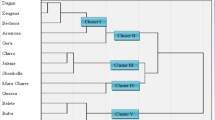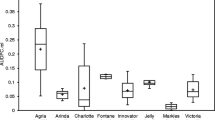Abstract
In 1991 and 1992, 12 potato cultivars were screened at two locations for resistance to blackleg, after vacuum infiltration of the seed withErwinia carotovora subsp.atroseptica orE. chrysanthemi. Cultivar differences for resistance toE.c. subsp.Atroseptica andE. chrysanthemi were found which were consistent over locations and years. Seed tubers of the same cultivars were also screened for resistance to bothErwinia spp. by using a tuber slice inoculation method. Correlation coefficients for comparisons between resistance to blackleg in the field and tuber tissue resistance under aerobic or anaerobic conditions were not significant. This could partly be explained by drastic changes in relative tuber tissue resistance of the cultivars within a 5 weeks period after planting in the field. Presprouting of seed tubers in diffuse daylight had a less pronounced effect on relative tuber tissue resistance than planting in the field. Monitoring the process of mother tuber decay during the growing season of 1993 after vacuum infiltration withE.c. subsp.atroseptica andE. chrysanthemi revealed that cultivars differed in the extent to which these bacteria enhanced the process of mother tuber decay. These differences partly explained the cultivar differences for resistance to blackleg in the field.
Similar content being viewed by others
Abbreviations
- Eca :
-
Erwinia carotovora subsp.atroseptica
- Ech :
-
Erwinia chrysanthemi
- NOP:
-
Noordoostpolder
- Wag:
-
Wageningen
References
Allefs JJHM, Dooijeweert W van, Jong ER de, Prummel W and Hoogendoorn J (1995) Factors affecting potato tuber tissue resistance to pectolyticErwinia species in a tuber slice assay (Submitted)
Bain RA and Pérombelon MCM (1988) Methods of testing potato cultivars for resistance to soft rot of tubers caused byErwinia carotovora subsp.atroseptica. Plant Pathol 37: 431–437
Drew MC (1990) Sensing soil oxygen. Plant Cell Environ 13: 681–693
Gans PT, Jellis GJ, Little G, Logan C and Wastie RL (1991) A comparison of methods to evaluate the susceptibility of potato cultivars to blackleg (caused byErwinia carotovora subsp.atroseptica) in the field at different sites. Plant Pathol 40: 238–248
Hidalgo OA and Echandi E (1982) Evaluation of potato clones for resistance to tuber and stem rot induced byErwinia chrysanthemi. Am Potato J 59: 585–592
Hossain M and Logan C (1983) A comparison of inoculation methods for determining potato cultivar reaction to blackleg. Ann Appl Biol 103: 63–70
Lapwood DH and Legg PR (1983) The effect ofErwinia carotovora subsp.atroseptica (blackleg) on potato plants. I. Growth and yield of different cultivars. Ann Appl Biol 103: 71–78
Lapwood DH and Gans PT (1984) A method for assessing the field susceptibility of potato cultivars to blackleg (Erwinia carotovora subsp.atroseptica). Ann Appl Biol 104: 315–320
Lapwood DH and Read PJ (1985) A simplified slice method for assessing tuber susceptibility of potato cultivars toErwinia carotovora subsp.atroseptica. Plant Pathol 34: 284–286
Lapwood DH and Read PJ (1986a) A comparison of methods of seed tuber inoculation for assessing the susceptibility of potato cultivars to blackleg (Erwinia carotovora subsp.atroseptica) in the field. Ann Appl Biol 109: 287–297
Lapwood DH and Read PJ (1986b) The susceptibility of stems of different potato cultivars to blackleg caused byErwinia carotovora subsp.atroseptica. Ann Appl Biol 109: 555–560
Lapwood DH, Read PJ and Spokes J (1984) Methods for assessing the susceptibility of potato tubers of different cultivars to rotting byErwinia carotovora subspeciesatroseptica andcarotovora. Plant Pathol 33: 13–20
Lojkowska E and Kelman A (1989) Screening of seedlings of wildSolanum species for resistance to bacterial stem rot caused by soft rotErwinias. Am Potato J 66: 379–390
Munzert M (1975) Eine Methode zur Prüfung der Resistenz der Kartoffelpflanze gegenüber dem Erreger der Schwarzbeinigkeit (Erwinia carotovora var.atroseptica (van Hall) Dye). Potato Res 18: 308–313
Munzert M and Hunniss W (1980) Beziehungen zwischen den Resistenzen gegen Schwarzbeinigkeit, Naß- und Trockenfäule der Kartoffel (Solanum tuberosum L.). Z. Pflanzenzüchtg 85: 59–70
Payne RW, Lane PW, Ainsley AE, Bicknell KE, Digby PGN, Leech PK, Simpson HR, Todd AD, Verrier PJ, White RP, Gower JC, Tunnicliffe Wilson G and Paterson LJ (1987) Genstat 5 Reference Manual. Clarendon Press, Oxford
Pérombelon MCM (1988) Ecology of Erwinias causing stem and tuber diseases. In: Report of the planning conference on bacterial diseases of the potato, 1987, Lima, Peru (pp 143–177) International Potato Center, Lima
Pérombelon MCM (1992) Potato blackleg: Epidemiology, host-pathogen interaction and control. Neth J Plant Pathol 98 Supplement 2: 135–146
Pérombelon MCM and Kelman A (1980) Ecology of the soft rotErwinias. Ann Rev Phytopathol 18: 361–387
Pérombelon MCM and Kelman A (1987) Blackleg and other potato diseases caused by soft rotErwinias: Proposal for revision of terminology. Plant Dis 71: 283–285
Pérombelon MCM and Lowe R (1975) Studies on the initiation of bacterial soft rot in potato tubers. Potato Res 18: 64–82
Soest LJM van (1983) Evaluation and distribution of important properties in the German-Netherlands potato collection. Potato Res 26: 109–121
Wastie RL, Jellis GJ, Lapwood DH, Logan C, Little G and Phillips MS (1988) Assessing potato cultivars for resistance to tuber soft rot (Erwinia carotovora subsp.atroseptica) at four test centres in the UK. Potato Res 31: 67–72
Weber J (1988) Die Effizienz der Nassfäuleabwehr bei der Wundheilung von Karoffelknollen. 1. Bestimmung der befallsauslösenden Erregerdichte und ihrer Umweltbeeinflussung. Potato Res 31: 3–10
Weber J (1990)Erwinia — a review of recent research. In: Proceedings of the 11th triennial conference of the European association for potato research (pp 112–121)
Weber J and Jansen G (1984) Resistenzphysiologische Untersuchungen zur Induction und Ausbreitung bakterieller Knollennaßfäule bei Kartoffeln. Arch Phytopathol u Pflanzenschutz 20: 297–306
Young, N (1990) Seed Potato Systems in Developed Countries: Canada, The Netherlands and Great Britain. International Potato Center, Lima
Zadina J and Dobiáš K (1976) Möglichkeiten der Resistenzzüchtung gegen die Knollennaßfäule bei Kartoffeln. Tagungsber Akad Landwirtschaftswiss DDR 140: 207–219
Author information
Authors and Affiliations
Rights and permissions
About this article
Cite this article
Allefs, S.J.H.M., van Dooijeweert, W., de Jong, E.R. et al. The role of the seed tuber in determining partial resistance to potato blackleg caused byErwinia spp.. Eur J Plant Pathol 101, 189–199 (1995). https://doi.org/10.1007/BF01874765
Accepted:
Issue Date:
DOI: https://doi.org/10.1007/BF01874765




